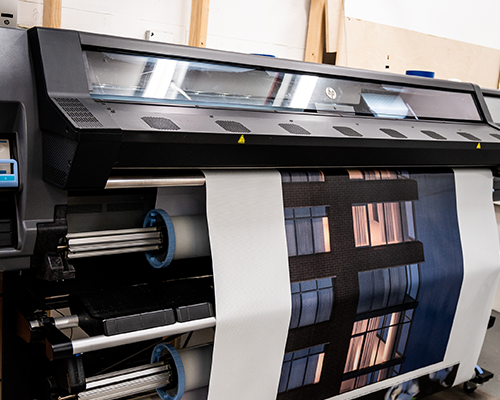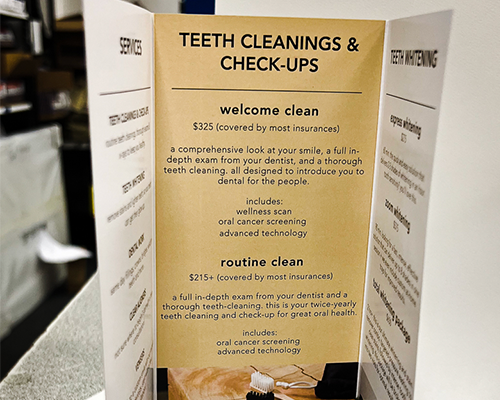Consulting with an experienced print company like Unique Print can help you make the right choice for your catalog printing project but you can also get started by thinking about the options below!
1. Catalog Size and Layout
Catalogs come in various sizes, but standard dimensions like 8.5” x 11” and 5.5” x 8.5” are the most common. Depending on your needs, you can also opt for custom sizes that suit your specific product offerings. The layout should be clean, organized, and easy to navigate. Design your catalog with categories, product groupings, and clear sections so readers can easily find what they’re looking for.
Some tips for effective layout:
Use consistent fonts and color schemes to create a cohesive look.
High-quality images: Make sure product images are sharp and clear to highlight details.
Callouts for special offers: Use attention-grabbing text for promotions or discounts.
2. Paper Options and Finishes
Paper quality plays a crucial role in how your catalog is perceived. You want a balance between durability and affordability. Popular paper options include:
Glossy Paper: Ideal for vibrant images and an upscale feel. Glossy catalogs are perfect for industries like fashion or high-end retail.
Matte Paper: Offers a more subtle and sophisticated look, reducing glare and making text easier to read. It works well for corporate or educational catalogs.
Cover Stock vs. Interior Stock: For the cover, a thicker and more durable stock should be used to give a premium, sturdy feel. Interior pages typically use a lighter stock to maintain flexibility.
Different paper coatings can also enhance the look and feel of your catalog:
UV Coating: Adds a glossy, high-shine finish to protect the pages and make colors pop.
Soft Touch Coating: Provides a smooth, velvety texture that exudes luxury.
3. Binding Methods
The binding method for your catalog influences both durability and cost. Choose a method based on the number of pages and the overall look you’re going for:
Saddle-Stitch Binding: Most suitable for catalogs with a smaller page count (typically fewer than 64 pages). Saddle-stitching involves folding sheets in half and stapling them along the spine, creating a simple and cost-effective booklet.
Perfect Binding: Ideal for thicker catalogs, perfect binding uses adhesive to glue the pages to a square spine. This method gives a professional, polished look, similar to a paperback book.
1. Catalog Size and Layout
Catalogs come in various sizes, but standard dimensions like 8.5” x 11” and 5.5” x 8.5” are the most common. Depending on your needs, you can also opt for custom sizes that suit your specific product offerings. The layout should be clean, organized, and easy to navigate. Design your catalog with categories, product groupings, and clear sections so readers can easily find what they’re looking for.
Some tips for effective layout:
Use consistent fonts and color schemes to create a cohesive look.
High-quality images: Make sure product images are sharp and clear to highlight details.
Callouts for special offers: Use attention-grabbing text for promotions or discounts.
2. Paper Options and Finishes
Paper quality plays a crucial role in how your catalog is perceived. You want a balance between durability and affordability. Popular paper options include:
Glossy Paper: Ideal for vibrant images and an upscale feel. Glossy catalogs are perfect for industries like fashion or high-end retail.
Matte Paper: Offers a more subtle and sophisticated look, reducing glare and making text easier to read. It works well for corporate or educational catalogs.
Cover Stock vs. Interior Stock: For the cover, a thicker and more durable stock should be used to give a premium, sturdy feel. Interior pages typically use a lighter stock to maintain flexibility.
Different paper coatings can also enhance the look and feel of your catalog:
UV Coating: Adds a glossy, high-shine finish to protect the pages and make colors pop.
Soft Touch Coating: Provides a smooth, velvety texture that exudes luxury.
3. Binding Methods
The binding method for your catalog influences both durability and cost. Choose a method based on the number of pages and the overall look you’re going for:
Saddle-Stitch Binding: Most suitable for catalogs with a smaller page count (typically fewer than 64 pages). Saddle-stitching involves folding sheets in half and stapling them along the spine, creating a simple and cost-effective booklet.
Perfect Binding: Ideal for thicker catalogs, perfect binding uses adhesive to glue the pages to a square spine. This method gives a professional, polished look, similar to a paperback book.
Spiral or Wire-O Binding: These methods are less common but offer functionality by allowing the catalog to lay flat when open. This binding type is excellent for catalogs that need to be handled frequently, such as industrial product guides or manuals.
4. Customizations
Adding custom features can elevate your catalog and make it stand out in a competitive market. Consider incorporating:
Foil Stamping: Adds a metallic effect to certain areas, like your logo or key headlines, giving your catalog an upscale, luxurious finish.
Embossing/Debossing: Use embossing to raise specific elements of the design, like logos or titles, or debossing to create recessed areas for a tactile effect.
Spot UV: This involves applying a glossy varnish to targeted areas (like the cover), making those elements shine and stand out from the rest.
Why Catalog Printing is Essential for Businesses
For many industries, catalog printing is more than just a marketing tool—it’s a crucial element in generating leads, driving sales, and maintaining customer loyalty. Here are a few reasons why catalog printing services are essential for businesses:
Comprehensive Product Display: Unlike flyers or brochures, catalogs allow you to showcase an extensive range of products or services, offering detailed descriptions and specifications to help customers make informed decisions.
Tangibility: Physical catalogs provide a tangible experience that digital ads and online stores can’t replicate. Customers can flip through pages, mark items of interest, and revisit the catalog whenever they need.
Increased Engagement: Studies show that people spend more time engaging with printed materials like catalogs compared to digital content. A well-designed catalog encourages readers to linger, browse, and explore, increasing the likelihood of purchase.
Brand Identity: Custom-designed catalogs reinforce your brand’s identity by incorporating your color scheme, fonts, and imagery. This ensures a cohesive message across all your marketing materials.
Optimizing Your Catalog for SEO
While physical catalogs don’t directly affect your online SEO, creating a digital version or embedding product catalogs on your website can significantly boost your search engine ranking. Here’s how to optimize your catalog for SEO:
Product Descriptions: Use clear, keyword-rich product descriptions that include essential details and specifications. This not only helps your customers but also improves search engine visibility.
Meta Tags: If you’re hosting your catalog online, include optimized meta titles, descriptions, and alt text for all images.
Internal Links: Use your catalog to drive traffic back to your website. Include QR codes or URLs that link directly to specific product pages.
Top SEO keywords for catalog printing include:
Custom catalog printing
Catalog printing services
High-quality catalog printing
Perfect bound catalogs
Saddle-stitched catalogs
How to Prepare Your Files for Catalog Printing
Ensuring your design files are print-ready is crucial for producing high-quality catalogs. Here’s a checklist to guide you through the process:
File Format: PDF is the preferred format for print, as it maintains design integrity and preserves high resolution.
Bleed and Margins: Include a bleed of at least 0.125” to ensure that images and designs extend to the edge of the page without leaving white borders.
Resolution: All images should be at least 300 DPI for clear, crisp printing. Lower resolutions can result in blurry or pixelated images.
CMYK Color Mode: Print designs should always be in CMYK color mode to ensure accurate color reproduction.
Proofing: Always request a proof to review colors, layout, and text placement before the final print run.
Choosing the Right Print Shop for Your Catalog
Selecting the right print shop for your catalog project is essential to getting the best results. Here are some key considerations:
Quality: Always ask to see samples of previous work to assess the print quality and finish options.
Turnaround Time: If you’re working on a tight deadline, ensure the print shop can deliver on time without compromising quality.
Customer Service: A good print shop should offer personalized service, including assistance with file preparation, proofs, and custom features.
Final Thoughts on Catalog Printing
Catalog printing services are a vital tool for businesses across various industries, from retail and real estate to education and nonprofits. Whether you’re looking to create a small product booklet or an extensive annual report, a well-crafted catalog can help you effectively engage your audience, present your offerings, and reinforce your brand’s identity.
Looking for catalog printing services in NYC? Contact us at Unique Print NY to discuss your project and see how we can help you create a high-quality, customized catalog that meets your business needs.










